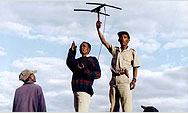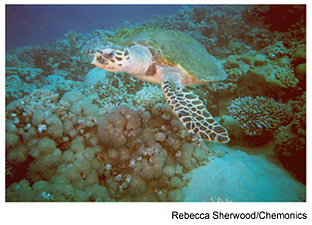 |
 |

 |
 |
Coastal and Coral Reef
 |
| A turtle swims through a coral reef in the Red Sea. |
As with any environment, the key to conserving biodiversity on coral reefs is through protecting the habitat, including water quality, by engaging the people to reduce threats. USAID supports projects in more than 20 countries that help protect coral reef ecosystems. Activities range from field programs promoting improved management practices and the establishment of marine parks and reserves to the promotion of sustainable tourism and fisheries. In addition, the Agency promotes better urban water management to improve coastal water quality. By conserving coral reef habitats, USAID protects the incredible biodiversity reefs support, as well as a vital base for sustained economic development in these countries.
Coral reefs are among the most biologically diverse ecosystems in the world. Reefs account for only 0.2 percent of the ocean’s area, yet they provide habitat for one-third of all marine species. Along with providing important habitat, coral reef fisheries yield one quarter of the total worldwide fish production in developing countries with coral reefs. Almost one billion people in East Asia alone depend on reefs as their primary source of protein.
They provide important protection to coastlines from storm damage, erosion and flooding, and support a growing sustainable tourism industry. Their contribution to the economies and environmental health of developing nations is immeasurable.
Despite their environmental and economic importance, coral reefs have experienced dramatic declines in the past two decades. Experts estimate that more than 60 percent of the world’s coral reefs are threatened by human activities, including coastal development, over-fishing, destructive fishing practices, and pollution. Among the greatest threats are warming water temperatures and increased carbon dioxide concentrations - both results of greenhouse gas emissions - that lead to coral bleaching.
USAID recognizes the importance of conserving coastal and coral reef habitats for their environmental and economic benefits. For example, in Indonesia, USAID helped establish three marine protected areas that are yielding significant ecological, economic, and infrastructure benefits to the fishermen and coastal communities of North Sulawesi. Coral cover and fish abundance is improving, bomb fishing is on the decline, ecotourism and new agriculture and seaweed farming activities are generating revenues, and numerous infrastructure improvements have been implemented. Due to the success of the three pilot sites, an additional 24 sites are now looking to establish community marine protected areas.
Back to Top ^
|
|
 |
 |
Tue, 27 Feb 2007 10:28:59 -0500
|
|
 |
 |


